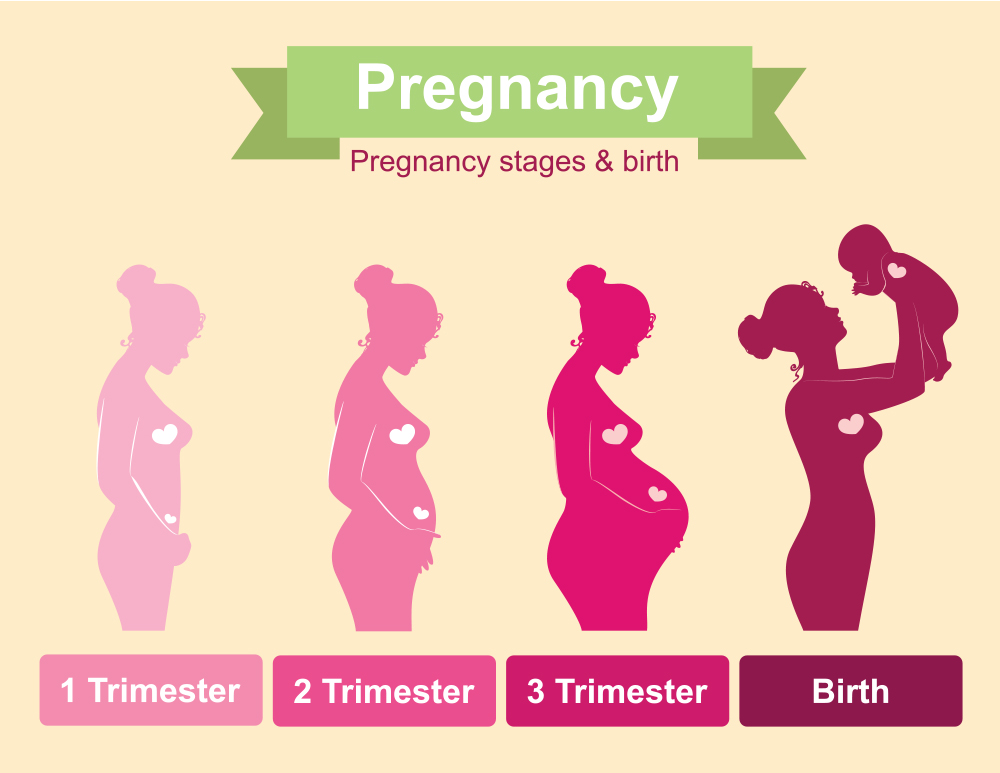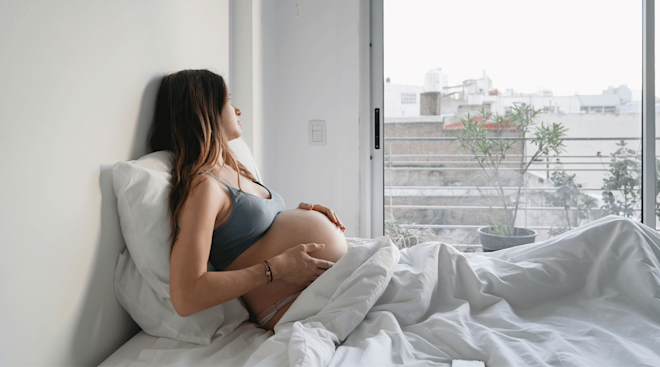
Third Trimester (Weeks 28–40): The Final Countdown
Share
The third trimester marks the final stage of pregnancy, filled with significant growth for your baby and changes for your body as you approach labor and delivery. During these weeks, your baby undergoes rapid growth, gaining weight and preparing for life outside the womb. By the end of this trimester, your baby may weigh around 5–8 pounds and measure between 18–21 inches long. They continue to develop essential systems, including the lungs, which mature for breathing after birth, and the brain, which is growing rapidly. As the baby moves into a head-down position in preparation for birth, you may feel more pressure on your pelvis and bladder, leading to more frequent trips to the bathroom.

For many women, the third trimester can bring physical discomfort. Back pain becomes more prominent as the baby’s weight puts strain on your spine, while swelling in the feet, ankles, and hands may increase due to the extra fluids in your body. Heartburn and shortness of breath can also become more common as your growing uterus presses against your stomach and diaphragm. As your body prepares for labor, you may also experience Braxton Hicks contractions, which are irregular practice contractions that help your body prepare for the real thing. These are generally harmless but can feel uncomfortable at times. Your bump will continue to grow, and you might notice stretch marks or skin changes, such as darkening around the nipples or a darker line running down your abdomen (known as the linea nigra).
Emotionally, you might feel a mix of excitement and anxiety as the due date draws near. Many women start to feel more nesting urges, organizing and preparing the baby’s nursery, packing a hospital bag, and tying up loose ends at home. Hormonal shifts can also cause mood swings or feelings of impatience, especially as you near the final days. It's important to focus on staying mentally and emotionally healthy, taking breaks, and practicing relaxation techniques to reduce stress. With the physical and emotional changes happening, self-care remains essential—getting enough rest, staying hydrated, and eating nutrient-rich foods will help you feel your best during this final stretch.
1. Week-by-week changes (baby gaining weight, moving into birth position)
Week 28:
At the beginning of the third trimester, the baby is around 2.5 pounds and 15 inches long. The baby’s eyes begin to open and close, and their brain is developing rapidly. The baby’s muscles and lungs are strengthening, preparing for breathing after birth. You may start to feel more frequent movements as the baby becomes more active. For the mom, swelling in the feet and ankles may begin to occur, and it might become harder to find a comfortable sleeping position due to the growing belly.
Week 29:
At 29 weeks, the baby is about 2.9 pounds and 16 inches long. Their skin is becoming less wrinkled as more fat is deposited under the skin, giving them a smoother appearance. The baby’s nervous system is also developing further, which means the baby may start responding to sounds and light. You might notice the baby’s movements becoming stronger, and this is the time when many women begin feeling shortness of breath due to the growing uterus pressing against the diaphragm.
Week 30:
By week 30, the baby weighs about 3 pounds and is roughly 16.5 inches long. They are getting more chubby as fat accumulates beneath the skin, especially in the arms and legs. The baby may begin to move into a head-down position in preparation for birth, although some babies may remain in breech or transverse positions. For the mom, back pain becomes more noticeable, as well as potential heartburn due to the baby’s position.
Week 31:
At this stage, the baby weighs around 3.3 pounds and measures about 17 inches. The baby’s bones are fully formed but still soft, and they are continuing to gain fat. Movements may feel stronger and more pronounced as there is less space in the womb for the baby to move. The mom may experience increased pelvic pressure as the baby descends, and the uterus continues to grow, which can lead to backache and frequent urination.
Week 32:
The baby is now about 3.8 pounds and 17.5 inches long. Their lungs are maturing, and the baby is practicing breathing motions by inhaling amniotic fluid. The baby’s bones are hardening, but the skull remains soft and flexible to assist in delivery. By this time, many babies are in the head-down position, but it’s still possible for them to be in breech or transverse positions. For moms, swelling in the feet and ankles may increase, and there’s more pressure on the pelvis as the baby’s head descends lower.
Week 33:
At 33 weeks, the baby weighs about 4 pounds and is approximately 18 inches long. Their brain is still developing, and the baby’s fat stores are increasing to help regulate body temperature after birth. The baby may continue to move into the birth position if they haven’t already. For the mom, Braxton Hicks contractions may occur more frequently as the body prepares for labor. It’s a good time to start thinking about packing your hospital bag and finalizing your birth plan.
Week 34:
By week 34, the baby weighs around 4.5 pounds and is about 18.5 inches long. Fat continues to accumulate under the skin, especially on the face and around the neck. The baby’s immune system is developing, and they may have some eyelashes and eyebrows. If the baby hasn’t already moved into the head-down position, there is still time for them to do so. For moms, swelling may become more pronounced, and fatigue can be significant as the body prepares for the final stretch.
Week 35:
At 35 weeks, the baby is around 5 pounds and 19 inches long. The baby’s lungs are almost fully developed, and they continue to practice breathing movements. They may be getting ready for birth by moving into the engaged position, where their head settles lower into the pelvis. For the mom, pelvic pressure intensifies, and frequent urination may continue as the baby drops lower. It’s also common for the mom to experience more Braxton Hicks contractions as the body prepares for labor.
Week 36:
The baby now weighs about 5.5 pounds and is about 19.5 inches long. By this stage, the baby’s bones are almost fully hardened, but their skull remains soft to aid the birth process. The baby may be in the head-down position and is continuing to grow and gain fat. The mother may experience increased pelvic pressure as the baby gets lower, and back pain may continue. It’s important to monitor any signs of early labor, such as regular contractions or leaking fluid.
Week 37:
At 37 weeks, the baby is considered early term, weighing around 6 pounds and 20 inches long. The baby’s lungs are fully matured, and they’re gaining fat for extra warmth after birth. Most babies have now moved into the head-down position, but if not, there’s still time for a breech or transverse baby to turn. For the mom, energy levels may fluctuate, and there may be more discomfort as the body prepares for delivery. It’s a good time to ensure that everything is in place for the baby’s arrival.
Week 38:
By week 38, the baby weighs around 6.5 pounds and measures 20.5 inches long. Their immune system is continuing to mature, and they are putting on fat for insulation and energy. The baby’s head-down position is generally confirmed by this point. The mom may experience increased fatigue, pelvic pressure, and frequent urination as the body gets closer to labor. Nesting instincts may be strong, and it's common to feel the need to prepare the home and organize baby items.
Week 39:
At 39 weeks, the baby weighs approximately 7 pounds and is around 21 inches long. The baby’s skin is smooth, and they are almost fully developed and ready for life outside the womb. The head-down position is now almost universal, and many moms begin to experience more intense Braxton Hicks contractions or even early labor signs. The baby’s bones are fully developed, except for the skull, which remains flexible to ease delivery. For the mom, there may be significant discomfort and a strong desire for the baby to arrive soon.
Week 40:
By 40 weeks, the baby is ready for birth, weighing around 7.5 pounds and measuring 21 inches long. They have fully matured and are prepared to enter the world. The baby’s skull is still flexible to assist in passing through the birth canal. As the baby drops further into the pelvis, you may feel a sense of pressure and increased discomfort. This marks the final week before labor begins, and it’s time to focus on your birth plan, ensuring you’re ready for your little one’s arrival.
2. Mom’s symptoms: frequent urination, sleep troubles, nesting instincts.
During the third trimester (weeks 28-40), moms experience a variety of physical and emotional changes as their bodies prepare for labor and delivery. Here are some common symptoms:

Frequent Urination:
As your baby grows, they start to put more pressure on your bladder, leading to the need for more frequent trips to the bathroom. The pressure from the baby, especially as they settle lower in the pelvis, can make it feel like you need to urinate more often, even if your bladder isn’t full. This can be especially pronounced at night, disrupting your sleep.
Sleep Troubles:
With the growing belly and the increased discomfort of the third trimester, sleep can become more difficult. You may struggle to find a comfortable sleeping position, as lying on your back or even your stomach is no longer feasible. Additionally, the physical discomfort from back pain, heartburn, and the need to use the bathroom can wake you up throughout the night. Hormonal changes may also contribute to feelings of restlessness or vivid dreams. Many women find that using pillows to support their body and sleeping on their side (preferably the left side for better circulation) can help improve comfort.
Nesting Instincts:
As your body prepares for the arrival of your baby, you may begin to experience nesting instincts—a surge of energy and the urge to prepare your home for the baby. This might involve organizing the nursery, cleaning, and getting everything ready for the baby’s arrival. While this can feel like a positive, productive energy, it’s also important to listen to your body and rest when needed, as overexertion can lead to fatigue.
These symptoms, while challenging at times, are all part of the body’s preparation for childbirth. Remember to stay hydrated, rest when you can, and ask for help from your partner or loved ones when needed.
3. Key checkups: GBS test, cervix checks, birth plan discussions.
During the third trimester (weeks 28–40), several important checkups and tests help ensure that both mom and baby are healthy and ready for labor. Here are the key checkups to expect:


GBS Test (Group B Streptococcus Test):
Between weeks 35 and 37, you will be tested for Group B Streptococcus (GBS), a common bacteria that can be present in the vagina or rectum. While GBS usually doesn't cause harm to healthy adults, it can be dangerous to a newborn if transmitted during childbirth. The test involves a simple swab of the vagina and rectum, and results are typically available within a few days. If you test positive for GBS, you will be given antibiotics during labor to reduce the risk of passing the bacteria to your baby.
Cervix Checks:
As you approach your due date, your healthcare provider may begin checking your cervix to see if your body is preparing for labor. These checks typically start around week 36 or 37, and the doctor will assess for signs of effacement (thinning of the cervix) and dilation (opening of the cervix). These checks can help determine if you're making progress toward labor, but they don't necessarily indicate when you’ll go into labor. Cervical checks are optional and may be uncomfortable, so it’s up to you whether you want them done.
Birth Plan Discussions:
As you near your due date, it’s a great time to have a conversation with your healthcare provider about your birth plan. This discussion helps ensure that your preferences for labor, delivery, and postpartum care are communicated. You can discuss various topics such as pain management options (e.g., epidural, natural pain relief), your birth environment (hospital, birthing center, home), and who will be present during labor. It’s also important to talk about your preferences for newborn care, such as feeding choices, skin-to-skin contact, and any concerns you have regarding labor and delivery. Keep in mind that while it's good to have a plan, flexibility is important as labor can unfold in unexpected ways.
These checkups and discussions are crucial for ensuring you’re well-prepared for childbirth, both physically and mentally. Make sure to bring up any concerns you have with your healthcare provider during these visits.
4. Tips for mom: packing hospital bags, labor prep, managing anxiety.
As you approach the final weeks of pregnancy, it’s important to prepare for labor and delivery. Here are some practical tips for moms during the third trimester:

Packing Your Hospital Bag:
Packing your hospital bag ahead of time ensures you're ready for labor when the time comes. Aim to have it packed by week 36 so you’re not scrambling at the last minute. Here are some essential items to include:
Comfortable clothes: Pack loose, comfortable clothing for both during labor and after delivery. Consider a robe, socks, and slippers.
Toiletries: Bring your toothbrush, toothpaste, hair ties, deodorant, face wash, lip balm, and any other personal hygiene items you may need.
Maternity bras and pads: You’ll need nursing bras if you plan to breastfeed, as well as maternity pads for postpartum bleeding.
Phone charger and camera: Don’t forget your phone charger, and consider packing a camera or any recording device to capture those special moments (if desired).
Snacks and drinks: Some hospitals allow snacks during early labor, so having a few light, energizing options on hand might be a good idea.
Documents: Include any necessary medical records, your ID, and your birth plan (if you have one).
Labor Preparation:
Preparing your body and mind for labor can make the experience more manageable. Consider these tips:
Prenatal classes: If you haven’t already, take a prenatal or birthing class. These classes offer valuable information about what to expect during labor and delivery, pain management options, and breathing techniques.
Practice relaxation techniques: Breathing exercises, meditation, and prenatal yoga can help reduce stress and prepare your body for the physical demands of labor.
Make a plan for support: Discuss with your partner, doula, or birthing team about your birth preferences, including pain management and who will be there to support you.
Stay active (within reason): Gentle activities like walking or pelvic tilts can help keep your body moving and make labor easier. Check with your doctor about safe exercises in the third trimester.
Managing Anxiety:
It’s normal to feel anxious as you approach the end of your pregnancy. Here are a few ways to ease your anxiety:
Educate yourself: The more informed you are, the less fearful you may feel. Understanding the process of labor and delivery, even if it doesn’t go as planned, can reduce feelings of uncertainty.
Talk about your fears: Share your worries with your partner, a trusted friend, or a therapist. Talking through your feelings can help relieve stress.
Trust your healthcare team: Remember that you are in good hands with your healthcare provider, nurses, and birth team. Trusting them can help ease anxiety.
Focus on the positive: While it’s natural to feel apprehensive, try to focus on the excitement of meeting your baby. Keep in mind the joy of bringing new life into the world, which can help shift your mindset toward optimism.
By preparing in advance and taking steps to manage anxiety, you can feel more confident and in control as you approach labor. Remember, no two births are alike, and while it’s great to have a plan, flexibility is key to navigating the experience.
